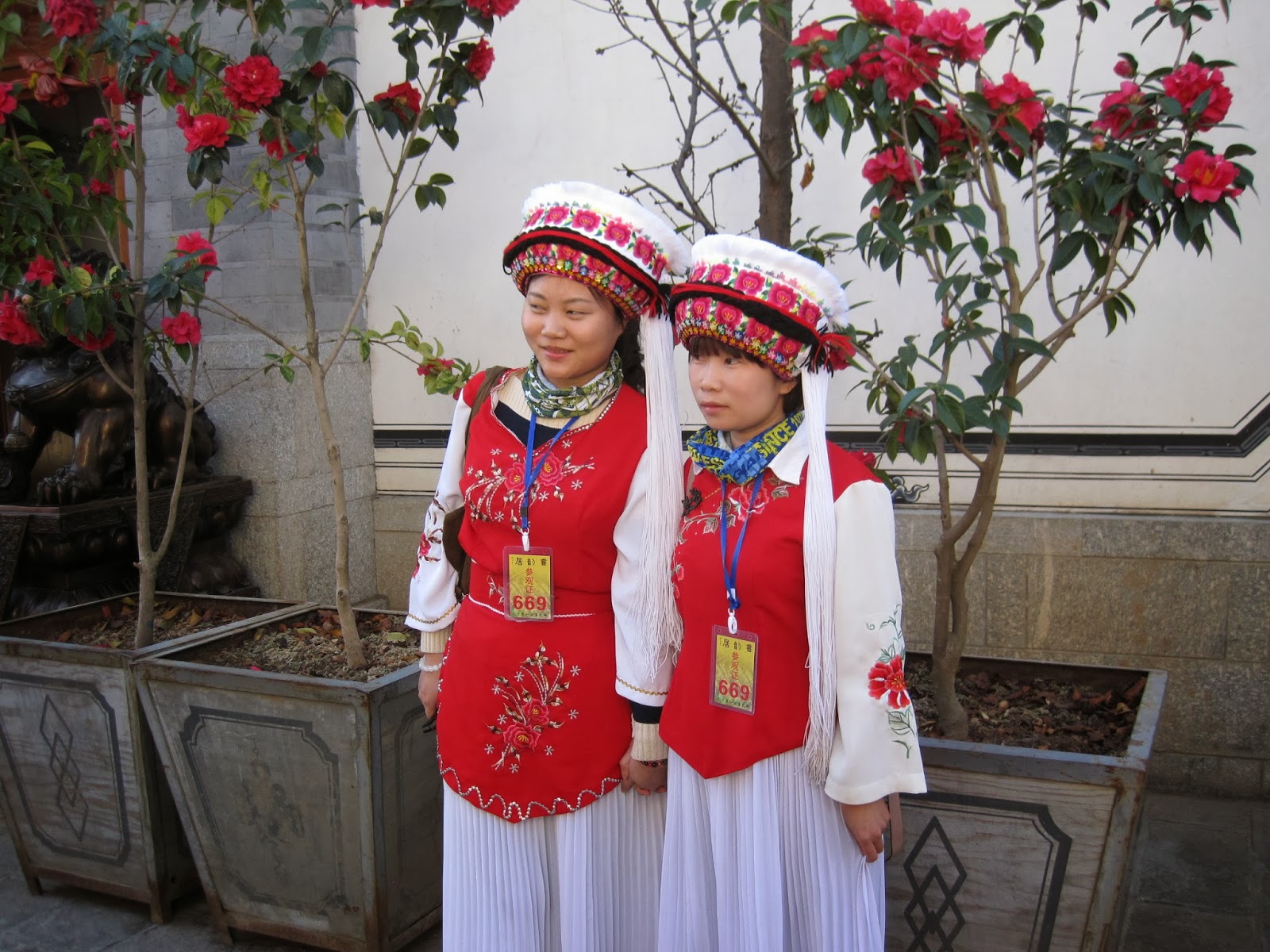The homes are designed around a courtyard, with three or five homes. The eastern wall of the courtyard should face the lake, so the western home receives the most light during the day and is often occupied by the older generation. The western part also should have the mountain in the background. Above the entrance to the courtyard may be a Phoenix or a Dragon. If the Phoenix is on the top that means the woman “rules”. If the Dragon is on the top, then the man is in charge!
Bai girls in their native costumes
Basket above the bedchamber of the bride and groom
The Butterfly is also an important symbol of love and
freedom. The Bai have three “Valentine’s
Days”: Feb. 14, July 7 and April 23-25
(Dali’s Valentine’s Day). On July 7,
those women 65 years or older may meet an old lover and he will give her a
gift, even if she is currently married!
Some entertainment during the tea ceremony
Lily was "loaned" a Bai outfit for the tea ceremony
That evening was the Chinese New Year, complete with loud
fireworks and people roaming around the streets and markets. It is a time for families to celebrate with
food and being together. We understood
that the fireworks would go off most of the evening, with loud boomers are midnight
and then again about 6am. That was
correct! Some of the BYU group decided to go outside at midnight. The staff of the hotel was lighting off fireworks. They invited the BYU teachers to join them in eating some homemade dumplings, a tradition on New Year's Eve. One woman told me they were the best dumplings she has eaten in China.
The east gate to the "old" city of Dali.
The entrance to our hotel in Dali, directly across from the east gate.
On Friday, we visited the three pagodas in Dali and explored the old
city. The main pagoda was built about
800 AD and the two smaller ones about 100 years later. They were built to honor Buddha and it was
also believed they would provide protection to Dali. “It was
recorded that Qianxun Pagoda had been split in an earthquake on May 6, 1515 AD
(Ming Dynasty). However, it miraculously recovered ten days later in
an aftershock. The most recent record of severe earthquake in the Dali area occurred in 1925. Only one in one
hundred buildings in Dali survived, but the Three Pagodas were undamaged.
(Wiki)”
The main pagoda is sixteen stories tall and hollow on the inside. The other two pagodas were damaged and now "lean". No tourists are allowed inside.
An offering at one of the temples honoring Buddha.
The Avalokitesvara’s main purpose is to listen to the cries for help from those in trouble and provide them with aid. He is the protector from danger and his sacrifice symbolizes infinite compassion, the sharing of mankind's misery and a willingness to help those in distress. . The famous Chinese view of Avalokitesvara is a women known as Kuan Yin (or Kwan Yin).
(Wiki)
Saturday, February 1, we visited the Stone
Forest, a few hours by bus from Kunming, China.
The formations were created by limestone pillars which were eroded by
wind and rain. The rest of the day was
on a flight to Guangshou, China so we could take an early morning flight to
Hanoi.
Sometimes our BYU group takes a mini bus and luggage is carried on laps or stacked in the back! There were 11 of us in this van with all our luggage on our way to the hotel in Guanzhou.
Lily and Nancy at the Stone Forest.
The Stone Forest is almost a maze. There are many corners and you can easily get lost.
Sometimes our BYU group takes a mini bus and luggage is carried on laps or stacked in the back! There were 11 of us in this van with all our luggage on our way to the hotel in Guanzhou.





















No comments:
Post a Comment